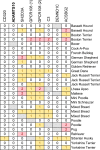Screening ADAMTS10 in dog populations supports Gly661Arg as the glaucoma-causing variant in beagles
- PMID: 23422823
- PMCID: PMC3604907
- DOI: 10.1167/iovs.12-10796
Screening ADAMTS10 in dog populations supports Gly661Arg as the glaucoma-causing variant in beagles
Abstract
Purpose: Previously, we mapped the disease locus in the beagle model of autosomal recessive primary open angle glaucoma (POAG) to a 4-Mb interval on chromosome 20, and identified a Gly661Arg variant in ADAMTS10 as the candidate disease-causing variant. The purpose of this study was to test the hypothesis that the Gly661Arg variant of ADAMTS10 causes glaucoma by genotyping dogs of various breeds affected and unaffected by primary glaucoma.
Methods: Dogs of various breeds, affected or unaffected with primary glaucoma, were genotyped for the Gly661Arg variant of ADAMTS10, as well as 7 other nonsynonymous single nucleotide polymorphisms (SNPs) in other genes in the beagle POAG locus that segregate with disease. Alternate allele frequencies were calculated with 95% confidence intervals and comparisons made to expected allele frequency relative to disease prevalence or between cases and controls.
Results: For the nonsynonymous SNPs other than the ADAMTS10 variant, control dogs were identified that were homozygous for the alternative alleles, ruling out those variants as causative. None of the nonsynonymous SNPs were found associated with primary glaucoma in American cocker spaniels. The Gly661Arg variant of ADAMTS10 was the only variant with minor allele frequency consistent with the prevalence of primary glaucoma in the general beagle population. The only dog found homozygous for the Gly661Arg variant of ADAMTS10 was an affected beagle, unrelated to the POAG colony.
Conclusions: These findings support the Gly661Arg mutation of ADAMTS10 as the likely cause of POAG in beagles.
Conflict of interest statement
Disclosure:
Figures





References
-
- Gelatt KN, Peiffer RL Jr, Gwin RM, Gum GG, Williams LW. Clinical manifestations of inherited glaucoma in the beagle. Invest Ophthalmol Vis Sci. 1977; 16: 1135–1142 - PubMed
-
- Peiffer RL Jr, Gum GG, Grimson RC, Gelatt KN. Aqueous humor outflow in beagles with inherited glaucoma: constant pressure perfusion. Am J Vet Res. 1980; 41: 1808–1813 - PubMed
-
- Peiffer RL, Jr, Gelatt KN. Aqueous humor outflow in beagles with inherited glaucoma: gross and light microscopic observations of the iridocorneal angle. Am J Vet Res. 1980; 41: 861–867 - PubMed
-
- Samuelson DA, Gum GG, Gelatt KN. Ultrastructural changes in the aqueous outflow apparatus of beagles with inherited glaucoma. Invest Ophthalmol Vis Sci. 1989; 30: 550–561 - PubMed
Publication types
MeSH terms
Substances
Grants and funding
LinkOut - more resources
Full Text Sources
Other Literature Sources
Medical
Molecular Biology Databases
Miscellaneous

